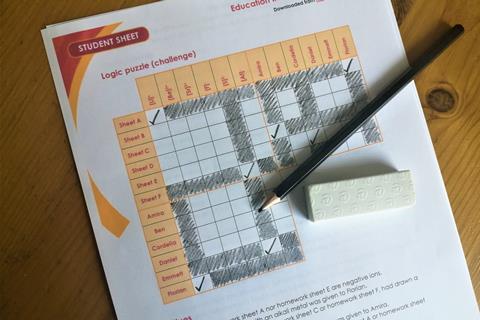Periodic Table Logic Problem Answers
Challenge learners to apply trouble-solving skills to a filigree-based logic problem which relies on chemical science knowledge about ions, charge and periodic table groups
This resource accompanies the Educational activity in Chemistry article Highly charged.
Learning objectives:
- Recognise descriptions of ions based on accuse and group number.
- Describe electron configuration diagrams for ions.
Introduction
A instructor set a homework task to describe electron configurations for different ions. Six of the students who handed in their homework sheets forgot to add their names. The students tin can't recall which ion they drew just they can remember some of the characteristics of those ions. The teacher has labelled each of the anonymous homework sheets with a letter A–F.
Instructions for learners

Use the clues to solve the logic puzzle to observe out which educatee submitted which ion for their homework.
You should not need a periodic tabular array to help you to solve most of the logic puzzle. You should use your noesis of grouping numbers and ion charges.
Instructions for teachers
The logic puzzle is a fun and challenging way to check understanding of the learning objectives. Withal, some learners may non have come beyond this style of puzzle earlier. Working in small-scale groups or completing the puzzle equally a whole form will allow learners to access the follow-upwards worksheet where they can practise drawing ions.
A version of the logic puzzle with only 2 categories is as well provided to support learners who find this format difficult to access. It tests the same scientific noesis.
Setting a fourth dimension limit afterward which the completed grid will be shared with all learners will help to keep the lesson moving and avert frustration at not being able to complete the puzzle.
Hints and tips
Encourage your learners to endeavor the puzzle, even if they oasis't tried annihilation like this before, by giving the following hints and tips:
- Yous practice not have to go through all the clues in order.
- Look for a clue you can solve easily if you are stuck.
- Skip a clue if you don't know what to do, you tin can come up dorsum to it later on.
- Once you have completed all the clues get through them from the beginning once more. You might take new information available the 2nd fourth dimension around.
- If you lot have filled in a tick in i of the sections, do you know annihilation else almost the items in that row or column that you lot tin transfer to some other section of the filigree?
More than resources
- Bank check students' understanding of why atoms form ions, and how ionic compounds form by ionic bonding, using this lesson program with activities for 16–xviii year olds.
- Build an cantlet from scratch, using protons, neutrons, and electrons with this interactive simulation. Exam different combinations to produce ions and unstable elements.
- Learn how to identify metal and not-metal ions in unknown solutions with our identifying ions practical video for 14-16 year olds.
- Find 101 sudoku-style chemistry puzzles with printable worksheets and answers to engage your students and consolidate their noesis about key topics.
Periodic Table Logic Problem Answers,
Source: https://edu.rsc.org/resources/ions-logic-puzzle-14-16-years/4015082.article
Posted by: freelandventis.blogspot.com


0 Response to "Periodic Table Logic Problem Answers"
Post a Comment